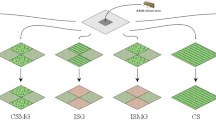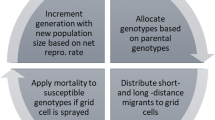Abstract
Transgenic cotton plants producing Bacillus thuringiensis (Bt) (Berliner) insecticidal proteins have contributed to the management of key lepidopteran pests. Larval high dispersal rates between non-Bt and Bt plants in landscapes with seed contamination can speed the evolution of insect resistance to Bt plants. We evaluated the effect of Bt and non-Bt cotton plants on the larval dispersal pattern and survival of susceptible, heterozygous and Cry1F-resistant Spodoptera frugiperda (J.E. Smith) (Lepidoptera: Noctuidae) genotypes in pure and contaminated artificial micro-landscape. A computer model was used to analyse the consequences of S. frugiperda larval dispersal behaviour on resistance evolution in refuge areas with different contamination levels and migration of different adult genotype combinations. The biological data from artificial micro-landscape experiments were used in simulations of macro-landscape scales. The Cry1F-resistant genotype avoided non-Bt cotton. The heterozygote had a similar larval dispersal behaviour as the susceptible genotype when non-Bt cotton was the central plant. Our simulations provide evidence that in refuge areas contaminated with Bt cotton plants, the evolution of resistance may be > 75-fold faster in relation to a contamination-free refuge. In conclusion, S. frugiperda resistance management practices on regional scales with contamination-free refuges are important to prevent loss in different crops.






Similar content being viewed by others
References
Agostinelli C (2012) CircStats: circular statistics, from “topics in circular statistics”. R package version 0.2-4. https://CRAN.R-project.org/package=CircStats. Accessed 25 Dec 2017
Agostinelli C, Lund U (2017) R package ‘circular’: circular statistics (version 0.4-93). https://r-forge.r-project.org/projects/circular/. Accessed 25 Dec 2017
Almeida LG, Beraldo de Moraes LA, Trigo JR, Omoto C, Cônsoli FL (2017) The gut microbiota of insecticide-resistant insects houses insecticide-degrading bacteria: a potential source for biotechnological exploitation. PLoS ONE 12:e0174754. https://doi.org/10.1371/journal.pone.0174754
Arias O, Cordeiro E, Corrêa AS, Domingues FA, Guidolin AS, Omoto C (2019) Population genetic structure and demographic history of Spodoptera frugiperda (Lepidoptera: Noctuidae): implications for insect resistance management programs. Pest Manag Sci. https://doi.org/10.1002/ps.5407
Azevedo da Silva R, Degrande PE, Gomes CEC, Souza EP, Leal MF (2018) Phytophagous insects in cotton crop residues during the fallow period in the state of Mato Grosso do Sul, Brazil. Pesq Agropec Bras 8:875–884
Bernardi D, Salmeron E, Horikoshi RJ, Bernardi O, Dourado PM, Martinelli S, Head G, Omoto C (2015) Cross-resistance between Cry1 proteins in fall armyworm (Spodoptera frugiperda) may affect the durability of current pyramided Bt maize hybrids in Brazil. PLoS ONE 10:e0140130. https://doi.org/10.1371/journal.pone.0140130
Caprio MA, Martinez JC, Porter PA, Bynum E (2016) The impact of inter-kernel movement in the evolution of resistance to dual-toxin Bt-corn varieties in Helicoverpa zea (Lepidoptera: Noctuidae). J Econ Entomol 109:307–319. https://doi.org/10.1093/jee/tov295
Carbonari CA, Latorre DO, Gomes GLGC, Velini ED, Owens DK, Pan Z, Dayan FE (2016) Resistance to glufosinate is proportional to phosphinothricin acetyltransferase expression and activity in LibertyLink® and WideStrike® cotton. Planta 243:925–933. https://doi.org/10.1007/s00425-015-2457-3
Carrière Y, Brown Z, Downes SJ, Gujar G, Epstein G, Omoto C, Storer NP, Mota-Sanchez D, Jorgensen PS, Carroll SP (2019) Governing evolution: a socioecological comparison of resistance management for insecticidal transgenic Bt crops among four countries. Ambio. https://doi.org/10.1007/s13280-019-01167-0
Carroll MW, Head G, Caprio MA (2012) When and where a seed mix refuge makes sense for managing insect resistance to Bt plants. Crop Prot 38:74–79. https://doi.org/10.1016/j.cropro.2012.02.015
Comins HN (1997) The development of insecticide resistance in the presence of migration. J Theor Biol 64:177–197
Farias JR, Horikoshi RJ, Santos AC, Omoto C (2014a) Geographical and temporal variability in susceptibility to Cry1F toxin from Bacillus thuringiensis in Spodoptera frugiperda (Lepidoptera: Noctuidae) populations in Brazil. J Econ Entomol 107:2182–2189. https://doi.org/10.1603/EC14190
Farias JR, Andow DA, Horikoshi RJ, Sorgatto RJ, Fresia P, Cesar dos Santos A, Omoto C (2014b) Field-evolved resistance to Cry1F maize by Spodoptera frugiperda (Lepidoptera: Noctuidae) in Brazil. Crop Prot 64:150–158. https://doi.org/10.1016/j.cropro.2014.06.019
Garcia AG, Cônsoli FL, Ferreira CP, Godoy WAC (2016) Predicting evolution of insect resistance to transgenic crops in within-field refuge configurations, based on larval movement. Ecol Complex 28:94–103. https://doi.org/10.1016/j.ecocom.2016.07.006
Gonçalves de Jesus F, Boiça Júnior AL, Alves GCS, Busoli AC, Zanuncio JC (2014) Resistance of cotton varieties to Spodoptera frugiperda (Lepidoptera: Noctuidae). Rev Colomb Entomol 40:158–163
Gouin A, Bretaudeau A, Nam K, Gimenez S, Aury JM, Duvic B, Fournier P (2017) Two genomes of highly polyphagous lepidopteran pests (Spodoptera frugiperda, Noctuidae) with different host-plant ranges. Sci Rep 7:11816. https://doi.org/10.1038/s41598-017-10461-4
Han P, Velasco-Hernández MC, Ramirez-Romero R, Desneux N (2016) Behavioral effects of insect-resistant genetically modified crops on phytophagous and beneficial arthropods: a review. J Pest Sci 89:859–883. https://doi.org/10.1007/s10340-016-0791-2
Head GP, Dennehy T (2010) Insect resistance management for transgenic Bt cotton. In: Zehr UB (ed) Cotton, biotechnology in agriculture and forestry. Springer, Cham, pp 113–125
Head GP, Greenplate J (2012) The design and implementation of insect resistance management programs for Bt crops. GM Crops Food Biotechnol Agric Food Chain 3:144–153. https://doi.org/10.4161/gmcr.20743
Horikoshi RJ, Bernardi O, Bernardi D, Okuma DM, Farias JR, Miraldo LL, Omoto C (2015) Near-isogenic Cry1F-resistant strain of Spodoptera frugiperda (Lepidoptera: Noctuidae) to investigate fitness cost associated with resistance in Brazil. J Econ Entomol 109:1–6. https://doi.org/10.1093/jee/tov387
Horikoshi RJ, Bernardi D, Bernardi O, Malaquias JB, Okuma DM, Miraldo LL, Omoto C (2016) Effective dominance of resistance of Spodoptera frugiperda to Bt maize and cotton varieties: implications for resistance management. Sci Rep 6:34864. https://doi.org/10.1038/srep34864
Lima EABF, Ferreira CP, Bernardes AM, Godoy WAC (2009) Neighborhood interactions and larval dispersal behavior in blowflies. J Insect Behav 22:245–255. https://doi.org/10.1007/s10905-008-9170-z
Malaquias JB, Godoy WAC, Garcia AG, Ramalho FS, Omoto C (2017) Larval dispersal of Spodoptera frugiperda strains on Bt cotton: a model for understanding resistance evolution and consequences for its management. Sci Rep 7:16109. https://doi.org/10.1038/s41598-017-16094-x
Mallet J, Porter P (1992) Preventing insect adaptation to insect-resistant crops: are seed mixtures or refugia the best strategy? Proc R Soc B 250:165–169. https://doi.org/10.1098/rspb.1992.0145
Martinelli S, Barata RM, Zucchi MI, Silva-Filho MC, Omoto C (2006) Molecular variability of Spodoptera frugiperda (Lepidoptera: Noctuidae) populations associated to maize and cotton crops in Brazil. J Econ Entomol 99:519–526. https://doi.org/10.1603/0022-0493-99.2.519
Martinelli S, Carvalho RA, Dourado PM, Head GP (2017) Resistance of Spodoptera frugiperda to Bacillus thuringiensis proteins in the western hemisphere. In: Fiuza L, Polanczyk R, Crickmore N (eds) Bacillus thuringiensis and Lysinibacillus sphaericus. Springer, Cham, pp 273–288
Martinez JC, Caprio MA, Friedenberg NA (2017) Density dependence and growth rate: evolutionary effects on resistance development to Bt (Bacillus thuringiensis). J Econ Entomol 111(1):382–390. https://doi.org/10.1093/jee/tox323
Miller NJ, Sappington TW (2017) Role of dispersal in resistance evolution and spread. Curr Opin Insect Sci 21:68–74. https://doi.org/10.1016/j.cois.2017.04.005
Moral RA, Hinde J, Demétrio CGB (2017) Half-normal plots and overdispersed models in R: the hnp package. J Stat Softw 81:1–23. https://doi.org/10.18637/jss.v081.i10
Omoto C, Bernardi O, Salmeron E, Sorgatto RJ, Dourado PM, Crivellari A, Head GP (2016) Field-evolved resistance to Cry1Ab maize by Spodoptera frugiperda in Brazil. Pest Manag Sci 72:1727–1736. https://doi.org/10.1002/ps.4201
Prasifka JR, Hellmich RL, Sumerford DV, Siegfried BD (2009) Bacillus thuringiensis resistance influences european corn borer (Lepidoptera: Crambidae) larval behavior after exposure to Cry1Ab. J Econ Entomol 102:781–787. https://doi.org/10.1603/029.102.0240
Ramalho FS, Azeredo T, Bezerra de Nascimento AR, Fernandes FS, Nascimento Júnior JL, Malaquias JB, Zanuncio JC (2011) Feeding of fall armyworm, Spodoptera frugiperda, on Bt transgenic cotton and its isoline. Entomol Exp Appl 139:207–214. https://doi.org/10.1111/j.1570-7458.2011.01121.x
Ramalho FS, Pachú JKS, Lira ACS, Malaquias JB, Zanuncio JC, Fernandes FS (2014) Feeding and dispersal behavior of the cotton leafworm, Alabama argillacea (Hübner) (Lepidoptera: Noctuidae), on Bt and non-Bt cotton: implications for evolution and resistance management. PLoS ONE 9:e111588. https://doi.org/10.1371/journal.pone.0111588
Ramalho FS, Pachú JKS, Lira ACS, Malaquias JB, Brito BDS, Zanuncio JC, Fernandes FS (2017) Effects of temperature on the feeding behavior of Alabama argillacea (Hübner) (Lepidoptera: Noctuidae) on Bt and non-Bt cotton plants. An Acad Bras Cienc 89:1–15. https://doi.org/10.1590/0001-3765201720150525
R Core Team (2017) R: a language and environment for statistical computing. R Foundation for Statistical Computing, Vienna, Austria. http://www.R-project.org/. Accessed 25 Dec 2017
Silva-Brandão KL, Horikoshi RJ, Bernardi D, Omoto C, Figueira A, Brandão MM (2017) Transcript expression plasticity as a response to alternative larval host plants in the speciation process of corn and rice strains of Spodoptera frugiperda. BMC Genom 18:792. https://doi.org/10.1186/s12864-017-4170-z
Sturtz S, Ligges U, Gelman A (2005) R2WinBUGS: a package for running WinBUGS from R. J Stat Softw 12:1–16. https://doi.org/10.7916/D80C55HH
Tabashnik B, Croft BA (1982) Managing pesticide resistance in crop-arthropod complexes: interactions between biological and operational factors. Environ Entomol 11:1137–1144
Yang F, Kerns DL, Head GP, Leonard BR, Levy R, Niu Y, Huang F (2014) A challenge for the seed mixture refuge strategy in Bt maize: impact of cross-pollination on an ear-feeding pest, corn earworm. PLoS ONE 9:e112962. https://doi.org/10.1371/journal.pone.0112962
Acknowledgements
We thank National Institute of Food and Agriculture, US Department of Agriculture, Coordenação de Aperfeiçoamento de Pessoal de Nível Superior—Brasil (CAPES)—Finance Code 001, Conselho Nacional de Desenvolvimento Científico e Tecnológico (CNPq) and Fundação de Amparo à Pesquisa do Estado de São Paulo (FAPESP) [FAPESP process details are in the Funding section]. We thank Fernando Semmelroth de Assunção e Amaral (ESALQUSP) for his assistance in the experiments. José Ednilson Miranda (Embrapa Cotton) and Claudia Pio Ferreira (UNESP-Botucatu) helped to improve the final version of the manuscript.
Funding
This study was funded by Fundação de Amparo à Pesquisa do Estado de São Paulo (FAPESP) (FAPESP process: 2018/20435-5, 2017/05953-7, 2015/20380-8) for granting the first author with Ph.D. and postdoctorate scholarships and for financing Project No. 2014/16609-7 (FAPESP). This material is also based upon work that is supported by the National Institute of Food and Agriculture, US Department of Agriculture, Hatch Project MIS-151210. WACG, FSR and CO are supported by research fellowship from the Brazilian National Council for Scientific and Technological Development (CNPq).
Author information
Authors and Affiliations
Corresponding author
Ethics declarations
Conflict of interest
The authors declare that there is no conflict of interest.
Ethical approval
All applicable international, national and/or institutional guidelines for the care and use of insects were followed.
Additional information
Communicated by R. Meyhöfer.
Publisher's Note
Springer Nature remains neutral with regard to jurisdictional claims in published maps and institutional affiliations.
Electronic supplementary material
Below is the link to the electronic supplementary material.
Rights and permissions
About this article
Cite this article
Malaquias, J.B., Caprio, M.A., Godoy, W.A.C. et al. Experimental and theoretical landscape influences on Spodoptera frugiperda movement and resistance evolution in contaminated refuge areas of Bt cotton. J Pest Sci 93, 329–340 (2020). https://doi.org/10.1007/s10340-019-01145-1
Received:
Revised:
Accepted:
Published:
Issue Date:
DOI: https://doi.org/10.1007/s10340-019-01145-1




